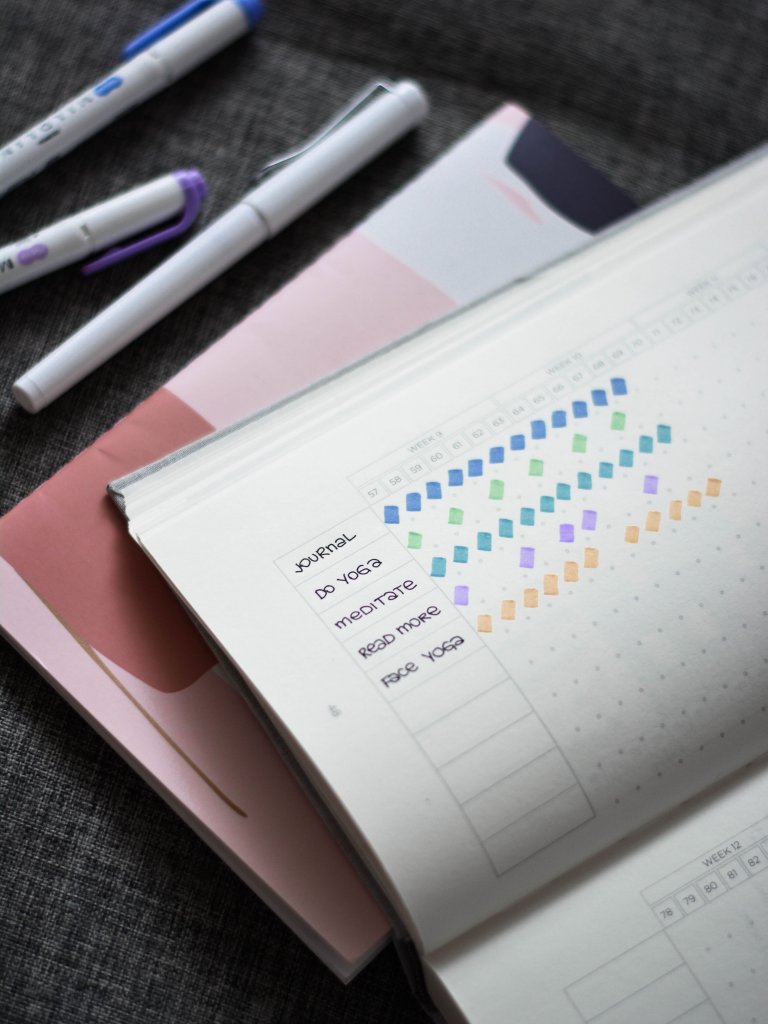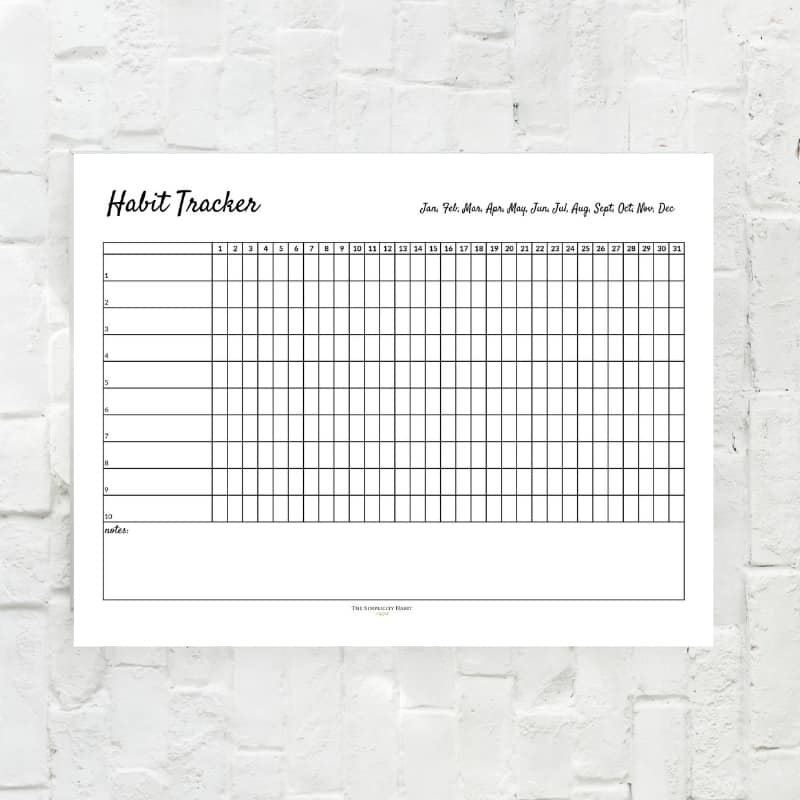I recently finished reading Atomic Habits by James Clear. This is a must-read for anyone who wants to change their habits (and who doesn’t??). In it, you’ll learn how simple Atomic Habits create big results.
Atomic habits are small changes that together cause a large impact. When you slightly improve various aspects of your life the end result can be a big change.
Have you ever heard the term compounding interest? In the finance world, even the smallest percent changes over time yield a great impact. Similarly, simple Atomic Habits create big results.

An overview
Disclosure: As an Amazon Associate I earn from qualifying purchases. Please note that I only recommend products I use and love. Click here to read my full disclosure policy.
So what can you expect to find in Atomic Habits by James Clear? I’m going to highlight what I found to be the key themes in the book so that you can get a sense for what it’s about. Hopefully, you’ll learn something even if you decide not to read it yourself.
Identity
The author begins by talking about how you first need to examine what you believe about yourself before you try to change your habits. You will be limited by what you believe you are capable of.
Usually, your actions won’t exceed your beliefs. If you don’t think you can achieve something, chances are quite good that you never will.
He goes on to explain how your thoughts and mindset matter. They impact the choices you make and the actions you take. Depending on your current thought patterns, you may need to pause at this stage to adjust your mindset before moving forward in creating new habits.
You can attempt to make whatever changes you desire, but they need to be aligned with your beliefs to achieve results.

Starting a new habit
James explains the process of habit formation which is cue, craving, response, and reward. It is a continual loop that’s occurring in our minds whether we consciously realize it or not.
An action will not occur without cue, craving, and response and will not be repeated if there is no reward.
All behavior occurs in an effort to solve a problem. An example he gives for the habit formation process is walking into a dark room (cue), wanting to be able to see (craving), flipping on a light switch (response), and being able to see (reward).
Turning on the
Four Laws of Behavior Change
The author created a simple set of rules which provide a framework for creating good habits and breaking bad habits.
- make it obvious
- make it attractive
- make it easy
- make it satisfying
If you are working on eliminating a bad habit, you’d want to make the inverse of those rules (invisible, unattractive, difficult, unsatisfying).
Obvious
To make something obvious, you can use the implementation intention strategy. That means determining ahead of time, I will x at y time in z location. For example, I will read my book at 6:30 am while sitting on the couch.
Habit stacking
Another method of habit creation is habit stacking. Habit stacking is when you take a current habit and pair a new habit with it.
If you already wake up at 6:30 am and drink your coffee, you could stack reading a book onto that current habit. This is a great way to add simple atomic habits to create big results.

Environment
In order to make it obvious, take your environment into consideration. It is easier to start a new habit in a new environment due to cues. If you are used to waking up at 6:30 and sitting at the table to drink coffee and look at your phone, it is likely you will default back to that behavior.
Selecting a new environment (the couch) can help with creating the new cue to read a book instead. Making the cue obvious in the environment, by leaving the book out on the coffee table the night before, will make it more likely for you to adopt the new habit.
When trying to stop a bad habit, it is easier to avoid temptation than resist it. He recommends cutting off bad habits by reducing exposure to the cue, thereby making it invisible. An example would be if you are trying to save money, reduce the cue by avoiding going to the mall or looking at stores online.
Attractive
The more attractive an opportunity is, the more likely it is to become habit forming. It becomes a dopamine-driven feedback loop. The anticipation of the reward motivates us to act. We are more motivated by the anticipation than the reward itself.
Temptation bundling
To create temptation bundling, pair an action you want to do with an action you need to do. For example, I can only listen to my audiobooks while I am cleaning the house. You’ve made the thing you need to do more appealing by pairing it with something you already enjoy.

Cultural influence
The culture in the home influences the attractiveness of behaviors. We normalize what we see in our home and if a practice is praised, we find it more attractive. We gravitate towards behaviors that get us approval, respect and praise.
We tend to adopt habits that are praised in our culture. People tend to imitate the habits of 3 social groups. They include family/friends, tribe/crowd and powerful people who have prestige and status.
One of the most effective ways to build better habits is to join a culture where the desired behavior is normal. It helps even more if you already have something in common with the group.
Reframe thoughts
How we think about habits matters. For creating a more difficult habit, it helps to reframe the thought patterns around it. Instead of thinking ugh I have to do laundry again. I hate doing laundry. Choose to instead think I need to do laundry again. I love having clean clothes. When we think in more positive terms, we are more likely to create habits that stick.
Routines
Creating routines is helpful in starting a new habit. If you begin a new behavior before you do something that you love, that habit will be associated with positive feelings. If you drink your favorite tea or coffee as you start your work, you will associate starting your workday with happier feelings.

Easy
According to the author, the most effective form of learning is practice not planning. He points out that people spend a great deal of time planning, but that doesn’t move the needle forward like practicing does.
Repetition
Habits form and eventually become automatic through repetition. The amount of time spent on habit is not as important as the number of times you have performed it.
It’s helpful to start with a shorter amount of time done more often. People naturally gravitate toward options that require the least effort, so starting simpler is better.
Start with the 2-minute rule for the new desired habit. You can standardize the practice of the new habit before optimizing it and making it longer.
Prime the environment
Set your environment up for success. If you want to drink more water, have a bottle of water readily apparent and with easy access.
Do you want to eat healthier snacks? Put them somewhere that you can easily grab them. Proximity and ease are part of the puzzle in creating new habits.

Automate
When possible, automate your habits. Set up automatic bill pay, have money automatically deposited into your retirement account. Control your phone usage by setting limits on an app that will shut it down for you.
It takes only a few minutes to set up and saves you a lot of time and effort in the long run. These automatic simple atomic habits create big results.
Satisfying
Unsurprisingly, you are more likely to repeat a behavior if the experience is satisfying. What is immediately rewarded is repeated and what is immediately punished is avoided.
The first three laws (obvious, attractive, and easy) impact the likelihood of habit happening once. This fourth law of satisfying effects how likely it would be that you’d repeat the habit.
Tracking
Putting numbers and data to habit creation helps keep you on track. It’s satisfying to feel like you’re making progress. A habit tracker will help you to have a greater awareness of your behavior. Trying to maintain a streak is motivating. If you miss a day, adopt a never miss twice rule to get right back on track.
To help you as you start your new habits, I created a free habit tracker that you can get by filling out the form below.

See how creating simple atomic habits creates big results in your life.
Accountability
Having an accountability partner increases the likelihood of creating desirable habits. We care what others think of us and knowing someone else is watching and will be checking in is a powerful motivator.
Creating a habit contract with a clear plan of action with rewards and consequences included is helpful for some people.
Additional things to consider:
Abilities
Choosing the right field for your gifts, talents, and skills sets you up for success. People have more natural abilities in certain areas than in others. When you pick the right habit, progress is easier.
Habit formation comes more naturally when aligned with your abilities. I could create all the habits I want to try and make me an NBA player, but it won’t make me taller or more coordinated for that to be a fit.
The Goldilocks Rule states that humans experience peak motivation when working on tasks that are right on the edge of their current abilities. You want to be challenged, but not have created an impossible scenario.
Boredom
The greatest threat to habit formation success is boredom. Those who succeed keep going despite the lull. Professionals learn to stick to a schedule regardless of how they feel, but amateurs let life and excuses get in the way.
Review
There is a potential downside to good habits. They can cause you to become blind to little errors. You get used to practicing a behavior out of ritual and can ignore how your performance could improve.
Designating time to reflect and review helps create a greater sense of awareness of performance over time.
If you get to an impasse in trying to create a new habit, revisit identity issues. The tighter the commitment to a particular identity, the harder it is to grow beyond it.

Conclusion
Simple Atomic Habits create big results and can be applied to any area of your life. It could be for something as simple as wanting to drink more water, spend less time on your phone, or take walks in nature. They can also work for work habits and productivity as well as health goals.
This is one of those few books that I enjoyed so much I will be ordering a copy to have on hand. It’s something I know I will want to return to and reference.
Atomic Habits has both statistics and data to back up its findings as well as many stories interwoven into it, which makes it an engaging read. I found it an easier and more enjoyable read than other habit books I’ve read in the past.
If you have any good habits you’d like to start or any bad habits you’d like to quit, read Atomic Habits or simply try some of the methods mentioned above and get started now. It will change your life.
Want to keep up to date on the latest Simplicity Habit information? Sign up below and also receive the Habit Tracker worksheet!







Wow, this is a great summary of Atomic Habits. I also have read this book, taken some notes here and there, and work to incorporate various things. You have a great compilation on this page. Some big points in that book that I like are: 1. optimize your environment – make it easy to do the habit you want, and hard to do what you don’t want. 2. Start small – if you want to read more, set out your book where you will see it, and the new habit is to read 1 page, or 2. You build the habit. 3. Your thoughts, words, and actions are establishing the “identity” you are striving for. “What would a healthy person eat?” “What would a fit person do here?”… and so on. 4. Habit stacking – take something you already do, and deliberately add a second habit you want to do. If you get up and make coffee, but want to drink more water, set your cup or water bottle next to the coffee maker.
On a related but slightly different book, Jim Kwik in his “Limitless” book talks about how we need to watch out for LIE and ANTs that will derail us from growth and improvement.
LIEs = limited ideas entertained
ANTs = automatic negative thoughts
What you speak to yourself, believe, and what other people speak to you can either build you up to greatness, or throw major roadblocks in your path. Look for the bright side of situations, if you fall down, get back up, believe you are going to be a little better each day.
Also in James Clear’s book, he mentions the story of a chess prodigy and describes how who you hang out with has a massive influence on what you’ll become. If you hang out with people who make excuses, bad mouth themselves and others, never amount to anything, that is what you’ll be.
Instead, if you associate with people who are upbeat, kind to themself but also hold themselves accountable when they mess up, who take action to improve their health, fitness, finances, learning, etc. you will embody these positive traits – and it will seem “normal” to do so.
I am loving your website as I look for ways to make our home and life less cluttered, more peaceful, and fulfilling. Thank you.
PS: I am also now reading Mel Robbins’ book, “The 5 second rule” and am enjoying it. Her podcast is also helpful and entertaining. OK, take a new step today towards your better self. 🙂